【单元一遍过】Unit 1 Making New Friends Topic 3 复习课件(共56张PPT)
文档属性
| 名称 | 【单元一遍过】Unit 1 Making New Friends Topic 3 复习课件(共56张PPT) | 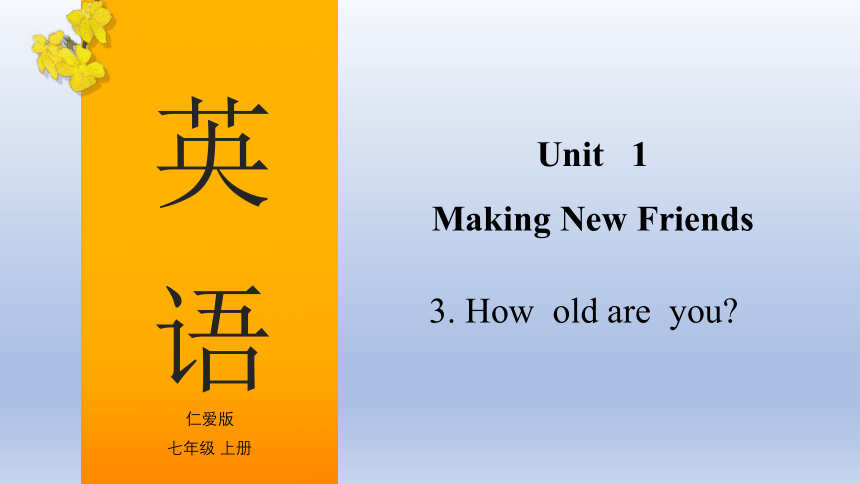 | |
| 格式 | pptx | ||
| 文件大小 | 5.0MB | ||
| 资源类型 | 教案 | ||
| 版本资源 | 仁爱科普版 | ||
| 科目 | 英语 | ||
| 更新时间 | 2023-07-12 22:23:11 | ||
图片预览

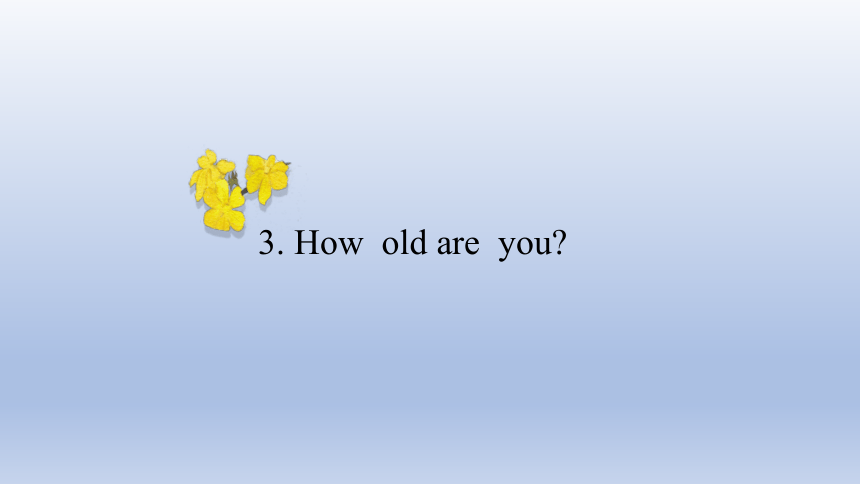
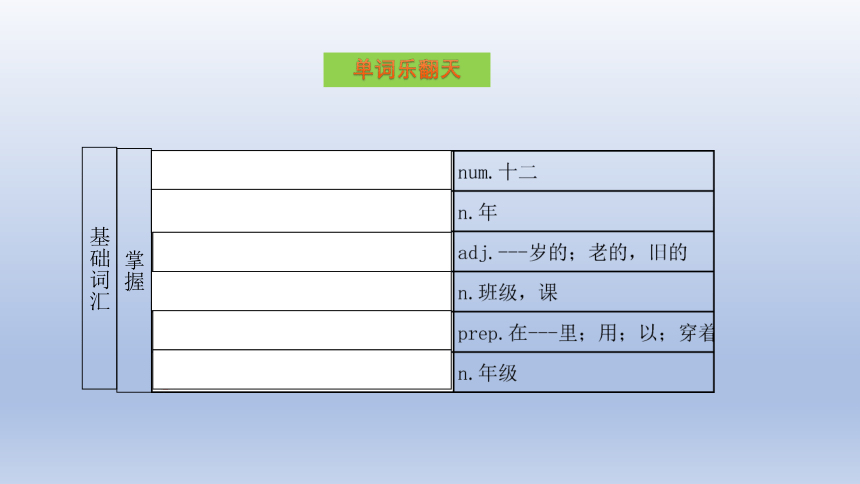
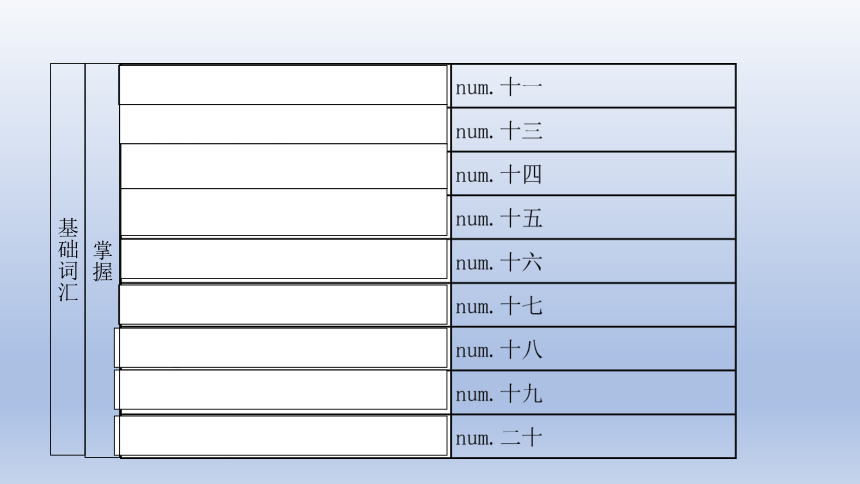

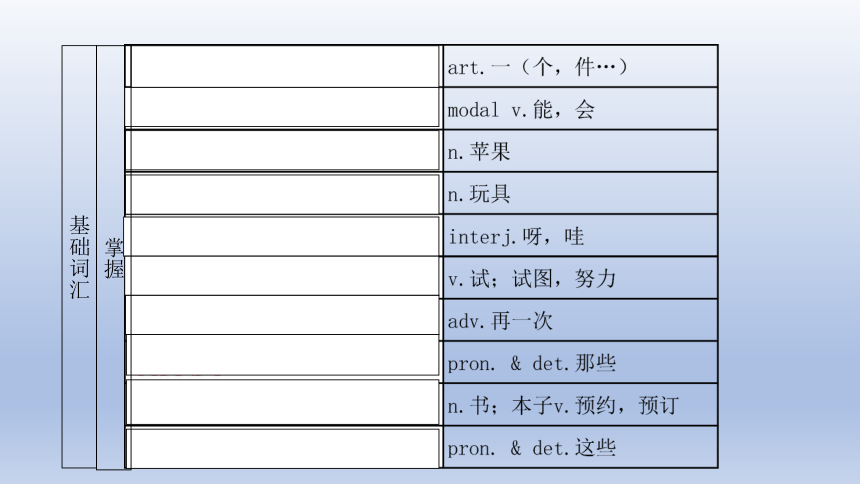
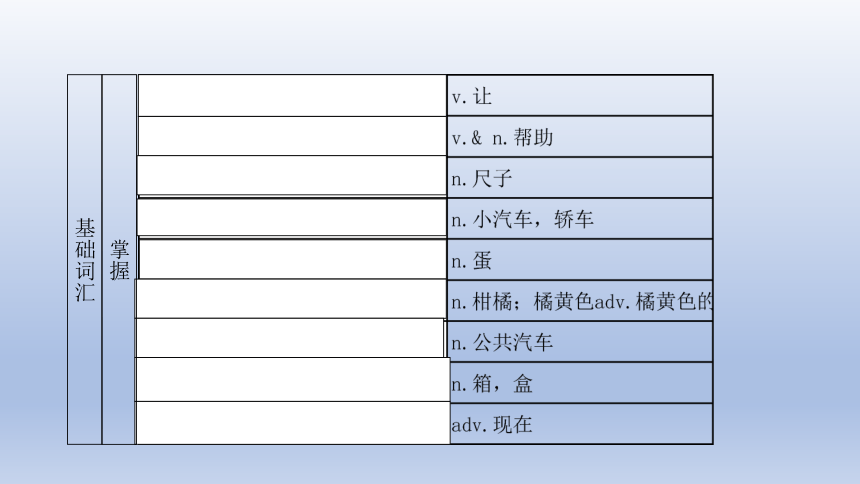
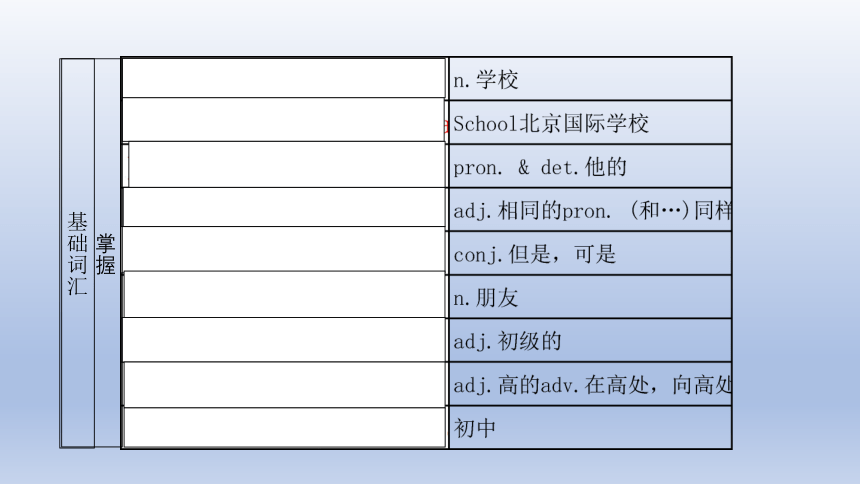
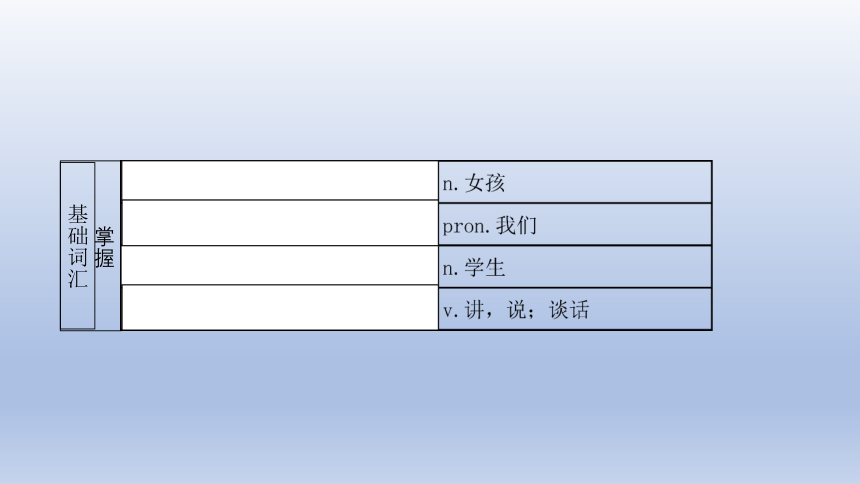
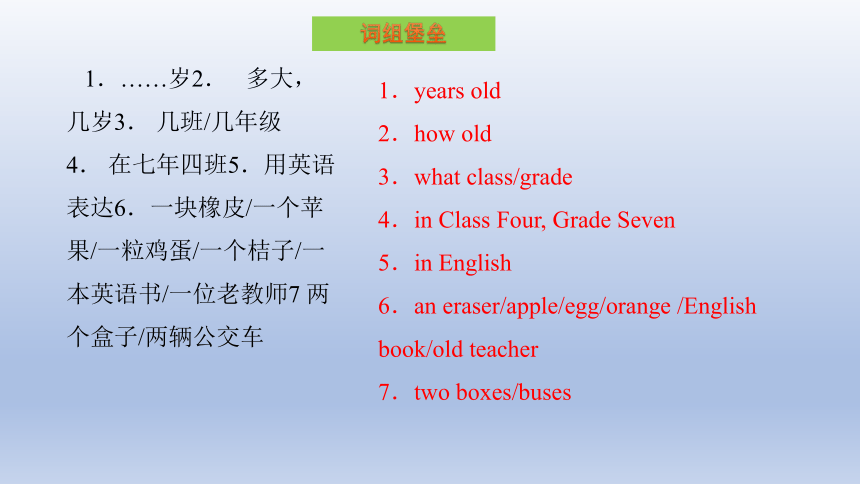
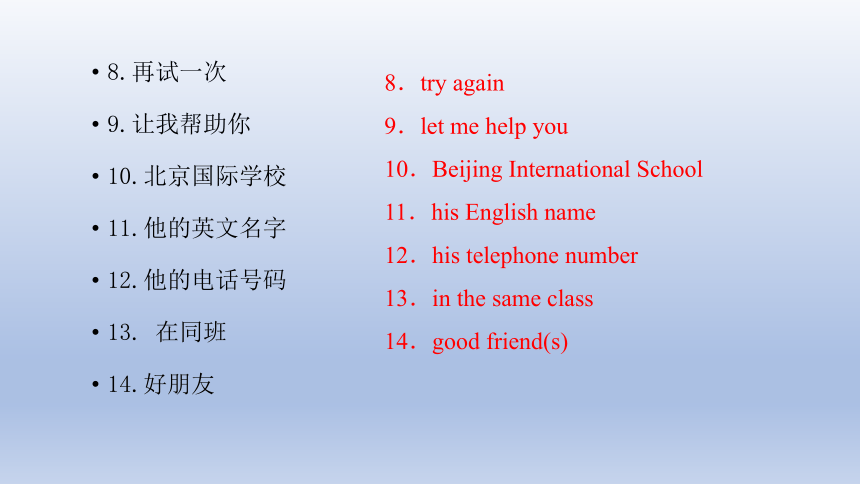
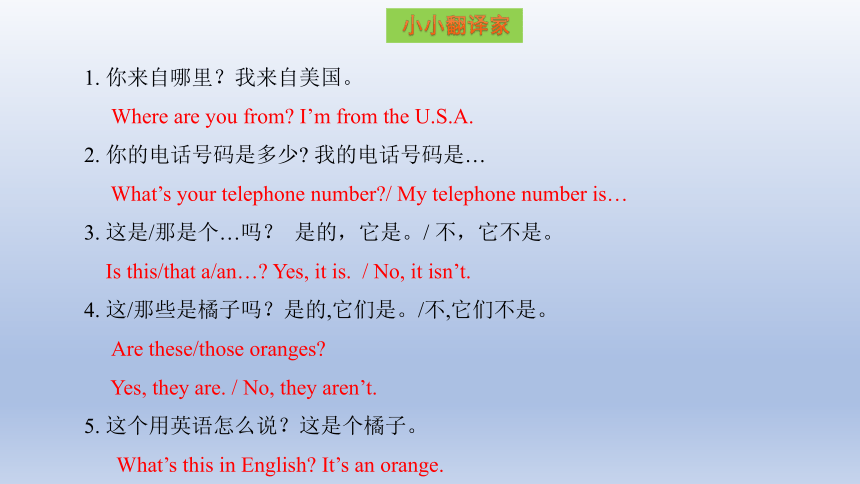
文档简介
(共56张PPT)
七年级 上册
Unit 1
Making New Friends
3. How old are you
英 语
仁爱版
3. How old are you
单词乐翻天
掌握
基础词汇
掌握
基础词汇
掌握
基础词汇
掌握
基础词汇
掌握
基础词汇
掌握
基础词汇
掌握
基础词汇
1.……岁2. 多大,几岁3. 几班/几年级4. 在七年四班5.用英语表达6.一块橡皮/一个苹果/一粒鸡蛋/一个桔子/一本英语书/一位老教师7 两个盒子/两辆公交车
1.years old
2.how old
3.what class/grade
4.in Class Four, Grade Seven
5.in English
6.an eraser/apple/egg/orange /English book/old teacher
7.two boxes/buses
词组堡垒
8.再试一次
9.让我帮助你
10.北京国际学校
11.他的英文名字
12.他的电话号码
13. 在同班
14.好朋友
8.try again
9.let me help you
10.Beijing International School
11.his English name
12.his telephone number
13.in the same class
14.good friend(s)
1. 你来自哪里?我来自美国。
Where are you from I’m from the U.S.A.
2. 你的电话号码是多少 我的电话号码是…
What’s your telephone number / My telephone number is…
3. 这是/那是个…吗? 是的,它是。/ 不,它不是。
Is this/that a/an… Yes, it is. / No, it isn’t.
4. 这/那些是橘子吗?是的,它们是。/不,它们不是。
Are these/those oranges
Yes, they are. / No, they aren’t.
5. 这个用英语怎么说?这是个橘子。
What’s this in English It’s an orange.
小小翻译家
6. 这/那些是什么?是书、苹果。
What are these/those They’re books/apples.
7. 你几岁了?我十二岁。
How old are you I am twelve.
8. 你在哪个班?我在七年四班。
What class are you in
I’m in Class Four, Grade Seven.
9. 你在哪个年级?我在七年级。
What grade are you in I’m in Grade Seven.
10. 你怎么拼写这个词?E-R-A-S-E-R, 橡皮擦。
How do you spell it E-R-A-S-E-R, eraser.
11. 你能拼写这个词吗?是的, M-A-P, 地图。
Can you spell it, please Yes, M-A-P, map.
12. 谢谢。 不用谢。
Thank you. /Thanks.
That’s OK. / You’re welcome.
13. 他们不在同一个班级,但是他们是好朋友。
They’re not in the same class, but they’re
good friends.
1.Do you like Chinese “你喜欢汉语吗?”
句型:“Do/Does+主语+like …?” “某人喜欢……吗?”
直击考点
( )—Jane doesn’t like ice cream or chicken.
—Peter doesn’t like ice cream either, but he likes chicken and eats it every day.(改编自2020 贵州黔西南)
A.a little B.very much C.at all
B
good是形容词, 用作表语或定语(放在be动词后、 名词前)。
“一份很好的工作” (2020 贵州黔西南)
well可用作形容词, 意为 “健康的, 身体好”, 也可用作副词来修饰动词。
“好好准备你的考试” (2021 江苏南京)
2.He can speak Chinese very well. “他汉语讲得很好。”
My Chinese is not very good. “我的汉语不是很好。”
a good job
prepare well for your exam
speak vi., 强调说话能力 speak to/with sb.“与某人谈话”; vt., 接语言 speak English。
talk vi., 侧重互相交流 talk with sb.about sth.“与某人谈论某事”。
tell vt., 告诉, 讲(故事、 笑话) tell sb.(about) sth.“告诉某人(关于)某事”; tell sb. a story/joke “给某人讲一个故事/笑话”。
say vt., 强调说的内容 say sth.to sb. “对某人说某事”, 也可接直接引语和间接引语。
【辨析】 speak, talk, tell和say
3.Maria shows a photo of her family to Kangkang.
“玛丽亚把她的家庭照片给康康看。”
(1)短语show sth.to sb.=show sb.sth.“把某物给某人看”。
“把它/它们给我看” show it/them to me
【辨析】这三个名词都有“家”的意思,但含义不同。
House意为“住宅、住家”,一般指居住的建筑物本身,兼指“家”、“家族”、或指“一家人”。
Home意为“家、家庭、住所”。指包括家人和住所的总称,强调某人出生以及抚养长大的环境。因而有“故乡”、“老家”等意义,指出生的城市或国家。
Family意为“家庭、家属”。指组成家庭的成员,特别是父母及其子女。
【例】The is built of stone.这房子是石头造的。
she is at .她在家。
I have a happy
(2) 【辨析】 family, home和house
family.
home
house
4.How old + be + 主语? 某人几岁? 回答: 主语 + be + 数字
—How old are you —I’m twelve (years old.)
你几岁?我十二岁。
—How old is Steve
—He is ____________ and he has an ___________ sister.
A. 13-year-old; 10 years old B. 13 years old; 11-year-old
C. 13 years old; 10-years-old D. 13-years-old; 11-years-old
【答案】B
【解析】“数字-名词-形容词”的结构表示的是符合形容词,一般作定语。在这种结构中应注意两点:一是用连字符,二是名词必须用单数。而“数字+名词(复数)+形容词”的结构,一般做作表语。根据本题中的两个空的位置可知,第一个是作表语,而第二个是作定语。所以本题选B。
【典例】
典型例题
5.—What class are you in —I’m in Class Five, Grade Eight
你在几班?我在八年五班。
What class / grade +be + 主语 + in 某人在哪一个班级/年级?
what class询问哪个班,what grade 询问哪个年级,之后有具体数字,它们和后面的数字的第一个字母必须大写,班级与年级之间要用逗号隔开。
What class are you in I am in Class Five. (注意:Class 和 Five需要大写)What grade are you in I am in Grade Seven.(注意:Grade 和 Seven需要大写)
--- What class are you in
--- I’m in ________________, Miss Li’s class.
A. class three grade seven B. Class three Grade seven
C. Class Three Grade Seven D. class Three grade Seven
【答案】C
【解析】句意:你在哪个班?我在七年级三班,李老师那个班。表示班级和年级时要大写,而且小单位在大单位前面,也就是班级在年级前面,故选C。
典型例题
6.Who’s = Who is 询问是谁,that指人
—Who’s this —This is Maria.
注意:This is 不能缩写成This’s
Who's that 那是谁?
that在此句中指代人,答语是That '.../It's....
——Hello, who is that
—— _____________ Jim speaking.
A. I’m B. My name is C. That’s D. This is
【答案】D
【解析】在电话用语中,不能用I‘m,也不能my name is ,故选答案为D。
典型例题
7.What’s this/ that (in English) 这(用英语说)是什么 回答:It’s a/an + 单数名词. 这是……
What’ re these/ those (in English) 这些(用英语说)是什么? 回答:They’re + 复数名词. 这些是……
A: What are these/those 这些/那些/它们是什么?
B: They’re /They are books. 它们是书。
in与表示语言的名词连用,表示用某种语言说 in Chinese/Japanese 用中文/日语表达
---What is this in English
---____________ a jacket.
A It’s B This is C That’s D They are
【答案】A
【解析】
这题考查特殊问句的回答:用it代替this,所以选A。
典型例题
如果你想问一个美国朋友手中所拿物件的英文名称,你应该说______
A. How do you do B. How do you spell it
C. What’s this in English D. How are you
【答案】C
【解析】
What’s this in English “这个用英语怎么说?”符合句意。选C。
典型例题
8.How do you spell it E-R-A-S-E-R, eraser. 你如何拼读它?E-R-A-S-E-R, eraser.
How do you spell it 是特殊疑问句,它强调的是怎么拼写的过程,不能用Yes/No回答;
Can you spell it 是一般疑问句,它强调的是能不能拼写这种能力,用Yes/No回答。
Can you spell it, please Yes. M-A-P, map. 你会拼读它吗?是的。M-A-P, map.
--_________ --Yes, W-A-T-C-H, watch.
A. Is it a watch B. Can you spell“watch”
C. How do you spell“watch” D. He can spell “watch”.
【答案】B
【解析】句意:——你会拼watch吗?——是的,W-A-T-C-H, watch.根据答语可知答案应选B。
考点:考查交际用语。
典型例题
--_______________. –J-A-C-K-E-T, jacket.
A. How do you spell it B. Can you spell it, please
C. What’s this in English D. Spell your name, please.
【答案】A
【解析】 句意:-你怎样拼写它?-J-A-C-K-E-T,jacket。How do you spell it 你怎样拼写它?Can you spell it, please 你能拼写一下吗?What’s this in English 这个用英语怎么说?Spell your name, please.请拼写一下你的名字。根据下面的回答可知选A。
考点:考查情景对话。
典型例题
8.You’re welcome=That’s OK.=That’s all right.=Not at all 不用谢
—Thank you.
—______
A. No,thanks! B. Yes,thanks.
C. That’s right. D. Not at all.
【答案】D
【解析】:No,thanks!不,谢谢; Yes,thanks,是的,谢谢; That’s right,那好吧; Not at all.一点也不,别客气。根据上文,谢谢你。下文应该表示客气,故选D。
考点:考查交际用语
典型例题
9.They are not in the same class.同义句:They are in different classes.
same前面要加“the”,后面的名词用单数形式;different后面的名词要用复数形式。
Tom and Mike are in ___________ school, but they are in ________classes.
A. same; the different B. same; different
C. different; the same D. the same; different
【答案】D
【解析】句意:汤姆和迈克在同一所学校,但他们在不同的班级。Same同样的,前面习惯加定冠词;different不同的,前面通常不要任何冠词。所以选D。
考点:考查形容词
典型例题
10.—Would you like some eggs?
=Do you want some eggs
“你想要些鸡蛋吗?”
—Yes, please./No, thanks. “好的, 太感谢了。”/“不, 谢谢你。”
would like用法:
would like +sth. 想要某物 +to do sth. 想做某事 +sb.to do sth. 想让某人做某事 (=want) Would you like …? 表示提出建议或要求。答语有: Yes, please./Yes, I would(I’d) love to/like to … /No, thanks.
(1) I would like some oranges.
=I want some oranges.
“我想要一些橙子。”
(2) “如果你想告诉我, 请打电话给我。”(改编自2021 江苏南京)
If you would like to tell me , please call me.
=If you want to tell me, please call me.
(3) “Lily 想让父母把她的钱放在银行卡里。” (改编自2020 辽宁丹东)
Lily would like her parents to put her money on the bank card.
=Lily wants her parents to put her money on the bank card.
11.Let me see. “让我想一想。”
Let me/us do sth.意为 “让我/我们做某事”。如:
( )But too much stress can stop you working to the best of your abilities, so it’s important not to let it of control.(改编自2021 江苏南京)
A.to get out B.gets out C.get out
C
12.They are all friendly/kind to me.
“他们都对我很友好。”
(1)be friendly/kind to sb. 意为 “对某人友好”。如:
他总是对对别人好。”(改编自2021 浙江台州)
He others/somebody else .
(2)all表示两者以上 “都”; 位置: be后动前。如:
“我们都在这儿。”
“他们都很喜欢我。”
is kind to
We are all here
We all like him very much.
13.I’m very glad to be here.
“我非常乐意待在这儿。”
be glad to do sth. “乐意做某事”
“我真的很高兴见到你。” (改编自2020 湖北孝感)
I feel really glad to meet you
一、 代词(人称代词、 反身代词、 指示代词、 不定代词和疑问代词等)
1.人称代词作主语要用主格; 作动词或介词的宾语要用宾格; 反身代词用于加强语气, 意为 “亲自”“自己”。
梳理语法
代词
指示代词
this(these) 用于指时间或空间上较近的事物
这是你的笔吗?
Is this your pen
这些是我的书。
These are my books.
that(those) 用于指时间或空间上较远的事物
那个字典是玛丽的。
That dictionary is Mary’s.
那些是你的书吗?
Are those your books
2.指示代词有时间或空间上远近的区别。
3.不定代词不明确代替任何特定名词或形容词, 修饰不定代词的词一般要后置。
another anybody/anyone anything each somebody/someone other
either enough everybody/everyone everything something one
less little much neither nobody/no one nothing
可数名词复数
both few fewer many others several
可数/不可数名词
all any more/most none such some
疑问代词
二、不定冠词 a / an
不定冠词 a / an用在单数可数名词前,表示某一类人或事物中的“一个”,相当于汉语“一”。
a /an的区别:
①a用在辅音音素开头的单词前
② an 用在元音音素开头的单词前
注意:音素指的是读音,而不是字母
a desk a book a table an apple an orange an honest boy
三. 规则可数名词的单复数变化形式。
名词单数变复数口诀
名词复数有变化,词尾常把-s加。
词尾若是s, x, ch, sh, 加上-es要记下。
若遇f, fe, 加-s之前要变-ve。
辅音字母加y来结尾,i替y再加-es。
词尾字母若是-o,加-es有两人和两菜。
还有一些不规则,咱来说一说。
oo常要变ee,男人女人a变e.
mouse的复数是mice,child的复数是children。
中国人和日本人很爱护绵羊、鹿和鱼,单数复数无变化。
四、 一般现在时
标志词: often, usually, sometimes, always, never, on Sundays, every day/month/year …
句子结构:
肯定句: 主语+be+ … /主语+V+ …
否定句: 主语+be+not+ … /主语+don’t /doesn’t+V原+ …
一般疑问句: Be+主语+ …?/Do/Does+主语+V原+ …?
注意: 主语是第三人称单数, 谓语动词后加s或者es; 主语不是第三人称单数, 谓语动词用动词原形。
五、 可数名词和不可数名词
1.可数名词: 能直接用基数词表示具体的量。如lion, watermelon, table, baby, bicycle, tree等。
2.不可数名词: 不能直接加数词表示具体的量, 需借助量词来表示, 且无单复数变化, 谓语动词一般用单数形式。
如money, butter, soap, paper, snow, sand。
注意: much, a little, little, a bit of, some, any, a lot of, plenty of等能修饰不可数名词, 表示不确定的数量。如:
“许多面包” “一点大米”
much bread
a little rice
1.当别人跟你说: Nice to meet you.的时候,你可以这样回答:
___________________________________________________.
2.你想知道Tim的表弟多大了,你可以这样问:
_____________________________,Tim
3. 你想知道对方的年龄,你可以这样问:
___________________________________________________
4.当别人夸奖你的时候,你可以这样说:
___________________________________________________.
Nice to meet you, too.
How old is your cousin,Tom
How old are you
Thanks. / Thank you.
情景交际
1. 假如你是Wang Hai。根据表格信息用英语写一段话, 介绍你和你的朋友Lily的情况。不少于50词。
Name Age From Class Grade Telephone number
Wang Ming 12 China 3 7 (010)8756-4321
Lily 11 England 6 7 (010)8769-5432
My name is Wang Hai. I am from China. I’m twelve years old. I am in Class Three, Grade Seven. My telephone number is (010)8756-4321. Lily is my good friend. She is from England. She is eleven years old. She is in Class Six, Grade Seven. Her telephone number is (010)8769-5432.
书面表达
七年级 上册
Unit 1
Making New Friends
3. How old are you
英 语
仁爱版
3. How old are you
单词乐翻天
掌握
基础词汇
掌握
基础词汇
掌握
基础词汇
掌握
基础词汇
掌握
基础词汇
掌握
基础词汇
掌握
基础词汇
1.……岁2. 多大,几岁3. 几班/几年级4. 在七年四班5.用英语表达6.一块橡皮/一个苹果/一粒鸡蛋/一个桔子/一本英语书/一位老教师7 两个盒子/两辆公交车
1.years old
2.how old
3.what class/grade
4.in Class Four, Grade Seven
5.in English
6.an eraser/apple/egg/orange /English book/old teacher
7.two boxes/buses
词组堡垒
8.再试一次
9.让我帮助你
10.北京国际学校
11.他的英文名字
12.他的电话号码
13. 在同班
14.好朋友
8.try again
9.let me help you
10.Beijing International School
11.his English name
12.his telephone number
13.in the same class
14.good friend(s)
1. 你来自哪里?我来自美国。
Where are you from I’m from the U.S.A.
2. 你的电话号码是多少 我的电话号码是…
What’s your telephone number / My telephone number is…
3. 这是/那是个…吗? 是的,它是。/ 不,它不是。
Is this/that a/an… Yes, it is. / No, it isn’t.
4. 这/那些是橘子吗?是的,它们是。/不,它们不是。
Are these/those oranges
Yes, they are. / No, they aren’t.
5. 这个用英语怎么说?这是个橘子。
What’s this in English It’s an orange.
小小翻译家
6. 这/那些是什么?是书、苹果。
What are these/those They’re books/apples.
7. 你几岁了?我十二岁。
How old are you I am twelve.
8. 你在哪个班?我在七年四班。
What class are you in
I’m in Class Four, Grade Seven.
9. 你在哪个年级?我在七年级。
What grade are you in I’m in Grade Seven.
10. 你怎么拼写这个词?E-R-A-S-E-R, 橡皮擦。
How do you spell it E-R-A-S-E-R, eraser.
11. 你能拼写这个词吗?是的, M-A-P, 地图。
Can you spell it, please Yes, M-A-P, map.
12. 谢谢。 不用谢。
Thank you. /Thanks.
That’s OK. / You’re welcome.
13. 他们不在同一个班级,但是他们是好朋友。
They’re not in the same class, but they’re
good friends.
1.Do you like Chinese “你喜欢汉语吗?”
句型:“Do/Does+主语+like …?” “某人喜欢……吗?”
直击考点
( )—Jane doesn’t like ice cream or chicken.
—Peter doesn’t like ice cream either, but he likes chicken and eats it every day.(改编自2020 贵州黔西南)
A.a little B.very much C.at all
B
good是形容词, 用作表语或定语(放在be动词后、 名词前)。
“一份很好的工作” (2020 贵州黔西南)
well可用作形容词, 意为 “健康的, 身体好”, 也可用作副词来修饰动词。
“好好准备你的考试” (2021 江苏南京)
2.He can speak Chinese very well. “他汉语讲得很好。”
My Chinese is not very good. “我的汉语不是很好。”
a good job
prepare well for your exam
speak vi., 强调说话能力 speak to/with sb.“与某人谈话”; vt., 接语言 speak English。
talk vi., 侧重互相交流 talk with sb.about sth.“与某人谈论某事”。
tell vt., 告诉, 讲(故事、 笑话) tell sb.(about) sth.“告诉某人(关于)某事”; tell sb. a story/joke “给某人讲一个故事/笑话”。
say vt., 强调说的内容 say sth.to sb. “对某人说某事”, 也可接直接引语和间接引语。
【辨析】 speak, talk, tell和say
3.Maria shows a photo of her family to Kangkang.
“玛丽亚把她的家庭照片给康康看。”
(1)短语show sth.to sb.=show sb.sth.“把某物给某人看”。
“把它/它们给我看” show it/them to me
【辨析】这三个名词都有“家”的意思,但含义不同。
House意为“住宅、住家”,一般指居住的建筑物本身,兼指“家”、“家族”、或指“一家人”。
Home意为“家、家庭、住所”。指包括家人和住所的总称,强调某人出生以及抚养长大的环境。因而有“故乡”、“老家”等意义,指出生的城市或国家。
Family意为“家庭、家属”。指组成家庭的成员,特别是父母及其子女。
【例】The is built of stone.这房子是石头造的。
she is at .她在家。
I have a happy
(2) 【辨析】 family, home和house
family.
home
house
4.How old + be + 主语? 某人几岁? 回答: 主语 + be + 数字
—How old are you —I’m twelve (years old.)
你几岁?我十二岁。
—How old is Steve
—He is ____________ and he has an ___________ sister.
A. 13-year-old; 10 years old B. 13 years old; 11-year-old
C. 13 years old; 10-years-old D. 13-years-old; 11-years-old
【答案】B
【解析】“数字-名词-形容词”的结构表示的是符合形容词,一般作定语。在这种结构中应注意两点:一是用连字符,二是名词必须用单数。而“数字+名词(复数)+形容词”的结构,一般做作表语。根据本题中的两个空的位置可知,第一个是作表语,而第二个是作定语。所以本题选B。
【典例】
典型例题
5.—What class are you in —I’m in Class Five, Grade Eight
你在几班?我在八年五班。
What class / grade +be + 主语 + in 某人在哪一个班级/年级?
what class询问哪个班,what grade 询问哪个年级,之后有具体数字,它们和后面的数字的第一个字母必须大写,班级与年级之间要用逗号隔开。
What class are you in I am in Class Five. (注意:Class 和 Five需要大写)What grade are you in I am in Grade Seven.(注意:Grade 和 Seven需要大写)
--- What class are you in
--- I’m in ________________, Miss Li’s class.
A. class three grade seven B. Class three Grade seven
C. Class Three Grade Seven D. class Three grade Seven
【答案】C
【解析】句意:你在哪个班?我在七年级三班,李老师那个班。表示班级和年级时要大写,而且小单位在大单位前面,也就是班级在年级前面,故选C。
典型例题
6.Who’s = Who is 询问是谁,that指人
—Who’s this —This is Maria.
注意:This is 不能缩写成This’s
Who's that 那是谁?
that在此句中指代人,答语是That '.../It's....
——Hello, who is that
—— _____________ Jim speaking.
A. I’m B. My name is C. That’s D. This is
【答案】D
【解析】在电话用语中,不能用I‘m,也不能my name is ,故选答案为D。
典型例题
7.What’s this/ that (in English) 这(用英语说)是什么 回答:It’s a/an + 单数名词. 这是……
What’ re these/ those (in English) 这些(用英语说)是什么? 回答:They’re + 复数名词. 这些是……
A: What are these/those 这些/那些/它们是什么?
B: They’re /They are books. 它们是书。
in与表示语言的名词连用,表示用某种语言说 in Chinese/Japanese 用中文/日语表达
---What is this in English
---____________ a jacket.
A It’s B This is C That’s D They are
【答案】A
【解析】
这题考查特殊问句的回答:用it代替this,所以选A。
典型例题
如果你想问一个美国朋友手中所拿物件的英文名称,你应该说______
A. How do you do B. How do you spell it
C. What’s this in English D. How are you
【答案】C
【解析】
What’s this in English “这个用英语怎么说?”符合句意。选C。
典型例题
8.How do you spell it E-R-A-S-E-R, eraser. 你如何拼读它?E-R-A-S-E-R, eraser.
How do you spell it 是特殊疑问句,它强调的是怎么拼写的过程,不能用Yes/No回答;
Can you spell it 是一般疑问句,它强调的是能不能拼写这种能力,用Yes/No回答。
Can you spell it, please Yes. M-A-P, map. 你会拼读它吗?是的。M-A-P, map.
--_________ --Yes, W-A-T-C-H, watch.
A. Is it a watch B. Can you spell“watch”
C. How do you spell“watch” D. He can spell “watch”.
【答案】B
【解析】句意:——你会拼watch吗?——是的,W-A-T-C-H, watch.根据答语可知答案应选B。
考点:考查交际用语。
典型例题
--_______________. –J-A-C-K-E-T, jacket.
A. How do you spell it B. Can you spell it, please
C. What’s this in English D. Spell your name, please.
【答案】A
【解析】 句意:-你怎样拼写它?-J-A-C-K-E-T,jacket。How do you spell it 你怎样拼写它?Can you spell it, please 你能拼写一下吗?What’s this in English 这个用英语怎么说?Spell your name, please.请拼写一下你的名字。根据下面的回答可知选A。
考点:考查情景对话。
典型例题
8.You’re welcome=That’s OK.=That’s all right.=Not at all 不用谢
—Thank you.
—______
A. No,thanks! B. Yes,thanks.
C. That’s right. D. Not at all.
【答案】D
【解析】:No,thanks!不,谢谢; Yes,thanks,是的,谢谢; That’s right,那好吧; Not at all.一点也不,别客气。根据上文,谢谢你。下文应该表示客气,故选D。
考点:考查交际用语
典型例题
9.They are not in the same class.同义句:They are in different classes.
same前面要加“the”,后面的名词用单数形式;different后面的名词要用复数形式。
Tom and Mike are in ___________ school, but they are in ________classes.
A. same; the different B. same; different
C. different; the same D. the same; different
【答案】D
【解析】句意:汤姆和迈克在同一所学校,但他们在不同的班级。Same同样的,前面习惯加定冠词;different不同的,前面通常不要任何冠词。所以选D。
考点:考查形容词
典型例题
10.—Would you like some eggs?
=Do you want some eggs
“你想要些鸡蛋吗?”
—Yes, please./No, thanks. “好的, 太感谢了。”/“不, 谢谢你。”
would like用法:
would like +sth. 想要某物 +to do sth. 想做某事 +sb.to do sth. 想让某人做某事 (=want) Would you like …? 表示提出建议或要求。答语有: Yes, please./Yes, I would(I’d) love to/like to … /No, thanks.
(1) I would like some oranges.
=I want some oranges.
“我想要一些橙子。”
(2) “如果你想告诉我, 请打电话给我。”(改编自2021 江苏南京)
If you would like to tell me , please call me.
=If you want to tell me, please call me.
(3) “Lily 想让父母把她的钱放在银行卡里。” (改编自2020 辽宁丹东)
Lily would like her parents to put her money on the bank card.
=Lily wants her parents to put her money on the bank card.
11.Let me see. “让我想一想。”
Let me/us do sth.意为 “让我/我们做某事”。如:
( )But too much stress can stop you working to the best of your abilities, so it’s important not to let it of control.(改编自2021 江苏南京)
A.to get out B.gets out C.get out
C
12.They are all friendly/kind to me.
“他们都对我很友好。”
(1)be friendly/kind to sb. 意为 “对某人友好”。如:
他总是对对别人好。”(改编自2021 浙江台州)
He others/somebody else .
(2)all表示两者以上 “都”; 位置: be后动前。如:
“我们都在这儿。”
“他们都很喜欢我。”
is kind to
We are all here
We all like him very much.
13.I’m very glad to be here.
“我非常乐意待在这儿。”
be glad to do sth. “乐意做某事”
“我真的很高兴见到你。” (改编自2020 湖北孝感)
I feel really glad to meet you
一、 代词(人称代词、 反身代词、 指示代词、 不定代词和疑问代词等)
1.人称代词作主语要用主格; 作动词或介词的宾语要用宾格; 反身代词用于加强语气, 意为 “亲自”“自己”。
梳理语法
代词
指示代词
this(these) 用于指时间或空间上较近的事物
这是你的笔吗?
Is this your pen
这些是我的书。
These are my books.
that(those) 用于指时间或空间上较远的事物
那个字典是玛丽的。
That dictionary is Mary’s.
那些是你的书吗?
Are those your books
2.指示代词有时间或空间上远近的区别。
3.不定代词不明确代替任何特定名词或形容词, 修饰不定代词的词一般要后置。
another anybody/anyone anything each somebody/someone other
either enough everybody/everyone everything something one
less little much neither nobody/no one nothing
可数名词复数
both few fewer many others several
可数/不可数名词
all any more/most none such some
疑问代词
二、不定冠词 a / an
不定冠词 a / an用在单数可数名词前,表示某一类人或事物中的“一个”,相当于汉语“一”。
a /an的区别:
①a用在辅音音素开头的单词前
② an 用在元音音素开头的单词前
注意:音素指的是读音,而不是字母
a desk a book a table an apple an orange an honest boy
三. 规则可数名词的单复数变化形式。
名词单数变复数口诀
名词复数有变化,词尾常把-s加。
词尾若是s, x, ch, sh, 加上-es要记下。
若遇f, fe, 加-s之前要变-ve。
辅音字母加y来结尾,i替y再加-es。
词尾字母若是-o,加-es有两人和两菜。
还有一些不规则,咱来说一说。
oo常要变ee,男人女人a变e.
mouse的复数是mice,child的复数是children。
中国人和日本人很爱护绵羊、鹿和鱼,单数复数无变化。
四、 一般现在时
标志词: often, usually, sometimes, always, never, on Sundays, every day/month/year …
句子结构:
肯定句: 主语+be+ … /主语+V+ …
否定句: 主语+be+not+ … /主语+don’t /doesn’t+V原+ …
一般疑问句: Be+主语+ …?/Do/Does+主语+V原+ …?
注意: 主语是第三人称单数, 谓语动词后加s或者es; 主语不是第三人称单数, 谓语动词用动词原形。
五、 可数名词和不可数名词
1.可数名词: 能直接用基数词表示具体的量。如lion, watermelon, table, baby, bicycle, tree等。
2.不可数名词: 不能直接加数词表示具体的量, 需借助量词来表示, 且无单复数变化, 谓语动词一般用单数形式。
如money, butter, soap, paper, snow, sand。
注意: much, a little, little, a bit of, some, any, a lot of, plenty of等能修饰不可数名词, 表示不确定的数量。如:
“许多面包” “一点大米”
much bread
a little rice
1.当别人跟你说: Nice to meet you.的时候,你可以这样回答:
___________________________________________________.
2.你想知道Tim的表弟多大了,你可以这样问:
_____________________________,Tim
3. 你想知道对方的年龄,你可以这样问:
___________________________________________________
4.当别人夸奖你的时候,你可以这样说:
___________________________________________________.
Nice to meet you, too.
How old is your cousin,Tom
How old are you
Thanks. / Thank you.
情景交际
1. 假如你是Wang Hai。根据表格信息用英语写一段话, 介绍你和你的朋友Lily的情况。不少于50词。
Name Age From Class Grade Telephone number
Wang Ming 12 China 3 7 (010)8756-4321
Lily 11 England 6 7 (010)8769-5432
My name is Wang Hai. I am from China. I’m twelve years old. I am in Class Three, Grade Seven. My telephone number is (010)8756-4321. Lily is my good friend. She is from England. She is eleven years old. She is in Class Six, Grade Seven. Her telephone number is (010)8769-5432.
书面表达
同课章节目录
- Unit 1 Making new friends
- Topic 1 Welcome to China!
- Topic 2 Where are you from?
- Topic 3 How old are you?
- Unit 2 Looking different
- Topic 1 I have a small nose
- Topic 2 What does she look like?
- Topic 3 Whose jacket is this?
- Unit 3 Getting togethe
- Topic 1 Does he speak Chinese?
- Topic 2 What do your parents do?
- Topic 3 What would you like to drink?
- Unit 4 Having fun
- Topic 1 What can I do for you?
- Topic 2 Would you like to cook with us?
- Topic 3 What time is it now?
